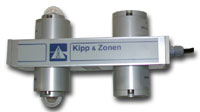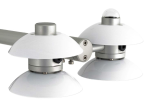This product is no longer available and has been replaced by: CNR4-L.

| Services Available | |
|---|---|
| Repair | No |
| Free Support | No |
Overview
The CNR1 net radiometer by Kipp & Zonen is for applications requiring research-grade performance. The radiometer measures the energy balance between incoming short-wave and long-wave IR radiation versus surface-reflected short-wave and outgoing long-wave IR radiation. The CNR1 consists of a pyranometer and pyrgeometer pair that faces upward and a complementary pair that faces downward. The pyranometers and pyrgeometers measure short-wave and far infrared radiation, respectively. The CNR1 also includes an RTD to measure the radiometer’s internal temperature and a heater that can be used to prevent condensation. Lead length is 82 ft. For custom cable length, order CNR1-L.
If you need a mounting bracket for a CNR1 or CNR1-L, get advice by clicking the Ask a Question button on this page, or call 435-227-9000 and ask to speak to someone in our Flux group.
Read MoreImages

Detailed Description
The CNR1 comes with an 82-ft cable length. This net radiometer is for applications requiring research-grade performance. It measures the energy balance between incoming short-wave and long-wave infrared radiation versus surface-reflected short-wave and outgoing long-wave infrared radiation.
The CNR1 consists of a pyranometer and pyrgeometer pair that faces upward and a complementary pair that faces downward. The pyranometers and pyrgeometers measure short-wave and far infrared radiation, respectively. All four sensors are calibrated to an identical sensitivity coefficient.
The CNR1 also includes an RTD to measure the radiometer’s internal temperature, a 4WPB100 module to interface the RTD with the data logger, and a heater that can be used to prevent condensation.
The CNR1 uses six differential or four single-ended and two differential analog channels on the data logger. Data loggers that provide sufficient channels include our CR1000, CR3000, and CR5000.
If you need a mounting bracket for a CNR1 or CNR1-L, get advice by clicking the Ask a Question button, or call 435-227-9000 and ask for someone in our Flux group.
Specifications
| Sensors | Kipp & Zonen’s CM3 ISO-class, thermopile pyranometer, CG3 pyrgeometer, PT100 RTD |
| Pyranometer Spectral Response | 305 to 2800 nm |
| Pyrgeometer Spectral Response | 5000 to 50,000 nm |
| Response Time | 18 s |
| Sensitivity Range | 7 to 15 μV W-1 m2 |
| Pyranometer Output Range | 0 to 25 mV |
| Pyrgeometer Output Range | ±5 mV |
| Expected Accuracy for Daily Totals | ±10% |
| Directional Error | < 25 W m-2 (pyranometer) |
| Heating Resistor | 24 ohm, 6 W (at 12 Vdc) |
| CE Compliance | CE compliant under the European Union’s EMC directive |
Compatibility
Note: The following shows notable compatibility information. It is not a comprehensive list of all compatible or incompatible products.
Data Loggers
| Product | Compatible | Note |
|---|---|---|
| 21X (retired) | ||
| CR10 (retired) | ||
| CR1000 (retired) | ||
| CR10X (retired) | ||
| CR200X (retired) | ||
| CR206X (retired) | ||
| CR211X (retired) | ||
| CR216X (retired) | ||
| CR23X (retired) | ||
| CR295X (retired) | ||
| CR3000 (retired) | ||
| CR500 (retired) | ||
| CR5000 (retired) | ||
| CR510 (retired) | ||
| CR800 (retired) | ||
| CR850 (retired) | ||
| CR9000 (retired) | ||
| CR9000X (retired) |
Additional Compatibility Information
Do Not use the UT018 crossarm with the 14364 mounting bracket to fasten the CNR1 to a tower leg. The 14264 mounting bracket should be attached directly to a verticle pole.
Data Logger Considerations
The CNR1 uses six differential or four single-ended and two differential analog channels on the data logger.
Documents
Brochures
Manuals
Frequently Asked Questions
Number of FAQs related to CNR1: 3
Expand AllCollapse All
-
As a general guide, go at least 1.5 m above the tallest plant (tree) in an ecosystem.
-
If the BR (Bowen Ratio) system is being run on 21X or CR23X dataloggers, a CNR1 net radiometer cannot be used with the system because those data loggers do not have enough input channels. For this reason, Campbell Scientific recommends running a CNR1 out of a separate data logger.
-
CNR1 is a four-output net radiometer. It gives values for incoming short-wave, incoming long-wave, outgoing short-wave, and outgoing long-wave radiation. It also calculates the net radiation and albedo.
Case Studies
The Geography Department at Bucknell University has implemented a weather station to obtain meteorological data......read more
Articles and Press Releases
Newsletter Articles
Privacy Policy Update
We've updated our privacy policy. Learn More
Cookie Consent
Update your cookie preferences. Update Cookie Preferences



